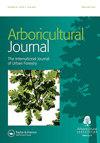疾病、衰老和根系生长
Q3 Agricultural and Biological Sciences
引用次数: 0
摘要
本版的《树木学杂志》包括三篇主要论文,其中介绍了对树木学的三种重要但差异很大的贡献,每一篇都解决了一个关键的问题。Jonathan Lageard使用了一种混合方法来获取种植在伦敦查特豪斯的桑树的生长和年龄的证据。这提供了一个有用的洞察种植果树的年代和使用和应用不同的信息来源,以帮助这一过程。Peter Del Tredici (Del Tredici, 2022)报告了一项截然不同的研究。Del Tredici再次谈到了一个非常被忽视的话题,他考虑了通常被忽视的内源性根及其发展和功能。这些结构是生长在具有明显心腐病的老树中的不定根的一种形式,实际上对树木和生长非常重要。此外,内胚根生长现象在山楂、桦树和紫菀等较小的老树中似乎非常显著;在适当的时候要报告的题目。这篇论文提供了一个显着的洞察力,什么是目前已知的和历史的研究这些知之甚少的根。作者还建议将“外缘”一词扩展到树枝与地面接触的不定根。该研究涉及了几个相当被忽视的主题,包括老柳树的空穴,树枝和倒下的树干的吸吮/生根,特别是在潮湿的景观中。这使我们超越了对古树和老树的典型研究,并有助于开辟新的调查和发现路线。最后,就论文而言,目前另一个非常重要的话题是经常灾难性树木疾病的传播。对于那些对外来疫霉感染感兴趣或关心的人,安德鲁·沃尔顿和安德鲁·史密斯对自然抗感染的文献进行了广泛的回顾。这是一个非常重要的话题,随着气候变化和日益全球化,这个问题在未来几十年肯定会变得更糟,而不是更好。因此,这种审查提供的见解是受欢迎的,而且特别有用。该问题以彼得·斯特肯(Sterken, 2022)给编辑的一封信结束(Sterken, 2022),解决了压缩分叉和公理的问题,最后是书评。本文章由计算机程序翻译,如有差异,请以英文原文为准。
Disease, aging, and root-growth
This edition of the Arboricultural Journal includes three major papers which present three significant but widely differing contributions to arboricultural science each one addressing a key matter of interest. Jonathan Lageard used a mixed methods approach to gaining evidence for the growth and age of mulberry trees planted at The Charterhouse in London. This provides a helpful insight into the dating of planted fruit trees and into the use and application of different sources of information to aid the process. A rather different piece of research is reported by Peter Del Tredici (Del Tredici, 2022). Again, addressing a very neglected topic, Del Tredici considers the generally neglected subject of endocormic roots and their development and function. These structures are a form of adventitious root growing inside older trees with significant heart-rot and in fact are very important in terms of tree and growth. Furthermore, the phenomenon of endocormic root growth appears to be highly significant in smaller veteran trees such as hawthorn, birch, and rowan; a topic to be reported on in due course. This present paper provides a remarkable insight into what is currently known and of the history of the study of these poorly understood roots. The author also suggests the term “epicormic” be extended for adventitious roots where branches meet the ground. The study touches on several rather neglected topics including hollowing of veteran willows, and suckering/rooting of branches and fallen trunks especially in wet landscapes. Much of this takes us beyond the typical research into ancient and veteran trees and helps open up new lines of investigation and of discovery. Finally in terms of the papers, another hugely important topic at present is the spread of often catastrophic tree diseases. For those interested in or concerned by exotic Phytophthora infections, Andrew Walton and Andrew Smith have presented a wide-ranging review of literature on natural resistance to infection. This is a very important topic and with climate change and increasing globalisation the problems will certainly get worse rather than better in the decades to come. Insights provided by such reviews are therefore welcomed and particularly helpful. The issue ends with a letter to the editor from Peter Sterken (Sterken, 2022) addressing the matter of compression forks and axioms, and finally with book reviews.
求助全文
通过发布文献求助,成功后即可免费获取论文全文。
去求助
来源期刊

Arboricultural Journal
Agricultural and Biological Sciences-Agronomy and Crop Science
CiteScore
2.40
自引率
0.00%
发文量
28
期刊介绍:
The Arboricultural Journal is published and issued free to members* of the Arboricultural Association. It contains valuable technical, research and scientific information about all aspects of arboriculture.
 求助内容:
求助内容: 应助结果提醒方式:
应助结果提醒方式:


